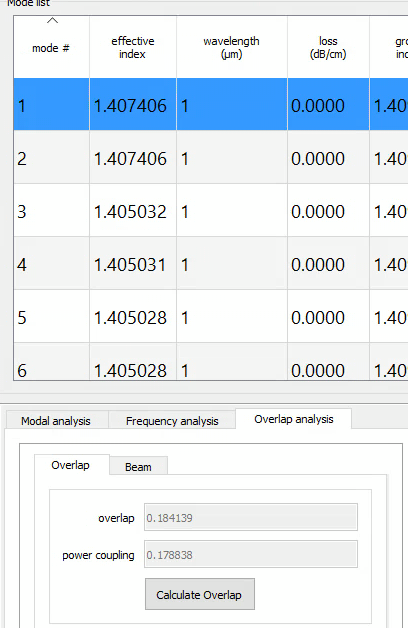-
-
April 3, 2022 at 6:41 pm
NFrench
SubscriberHello! I am trying to use FDE to find the power coupled into all the modes within a fiber optic from a gaussian beam. However, I am getting confused by the results of the power coupling calculations. Looking at the definition for power coupling, I was under the impression that I could simply sum up the power coupled in the individual modes from the beam to get the total power coupled in the fiber. Clearly 0.1788 + 0.858 is greater than 1, and I am confused why this would be so. Perhaps I am misunderstanding the definition for the power coupling calculation in FDE? Any advice is greatly appreciated!
April 4, 2022 at 9:38 pmGuilin Sun
Ansys EmployeeThis could be due to numerical error, in particular when more number of modes are used.
Are you using "overlap" or "expand2"?
April 5, 2022 at 4:51 pmNFrench
SubscriberI am using "overlap"
April 5, 2022 at 7:28 pmGuilin Sun
Ansys EmployeeIf so, I have not seen any theory that guarantees the sum of overlaps to be unity, like transmission and reflection. "overlap" is to compute the similarity of the modes. The overlap assume no reflections, but in physics there is some reflection. Some details can be found here:
https://support.lumerical.com/hc/en-us/articles/360034396834-Understanding-the-mode-overlap-calculation
ideally, we would know the reflection, which is not necessarily part of the incident fields.
So, I would suggest that you can simply ignore the difference to unity.
April 5, 2022 at 8:38 pmNFrench
SubscriberOkay, thanks for clarifying! I am trying to use the power coupling part of "overlap" to figure out at the beam angle at which power coupled in the fiber drops below a certain threshold (EX: 5%) though. Would this numerical error caused by the "power coupling" calculation be an issue or would it still be safe to ignore the difference to unity?
April 5, 2022 at 9:15 pmGuilin Sun
Ansys EmployeeAs the link suggested, if you want to have accurate coupling information, you will need to consider all the modes for the reflection and transmission. This can be done using EME. But you still meet some issues as how many modes to guarantee the error is small enough. "overlap" estimates the coupling, and its accuracy compared to actual power coupling will depend on the modes and the refractive index difference etc. I would suggest to simply ignore it, or use EME to accurately quantify the coupling with mode convergence, which might be a little challenge in some cases.
Viewing 5 reply threads- The topic ‘Issue with power coupling calculation in FDE solver’ is closed to new replies.
Ansys Innovation SpaceTrending discussionsTop Contributors-
3632
-
1313
-
1142
-
1068
-
1008
Top Rated Tags© 2025 Copyright ANSYS, Inc. All rights reserved.
Ansys does not support the usage of unauthorized Ansys software. Please visit www.ansys.com to obtain an official distribution.
-
The Ansys Learning Forum is a public forum. You are prohibited from providing (i) information that is confidential to You, your employer, or any third party, (ii) Personal Data or individually identifiable health information, (iii) any information that is U.S. Government Classified, Controlled Unclassified Information, International Traffic in Arms Regulators (ITAR) or Export Administration Regulators (EAR) controlled or otherwise have been determined by the United States Government or by a foreign government to require protection against unauthorized disclosure for reasons of national security, or (iv) topics or information restricted by the People's Republic of China data protection and privacy laws.












